Kate Waldron, Ellen Nigro and Maria Carolina Peña Mariño
Spending such a long period at home during lockdown made me realise how little I truly appreciated the ability that we had before to travel freely and explore the art and culture of other countries. Each year, a group of students, interns and staff from the Hamilton Kerr Institute go on a short study trip, usually to another country, to learn about paintings conservation in cultures other than our own. Sadly, the pandemic meant that our scheduled study trip to Amsterdam in May this year had to be cancelled. To make up for this, we’ve put together a blog post about our study trip to Italy in July 2019. It has been pleasant indeed to reminisce about this during the difficulties of this year, and we all hope that we will get to travel again before too long. I hope that the accounts below can provide some escapism for readers too.
Stoically undeterred by temperatures of 32°C and above, we packed a lot into the trip. For this reason, I have divided it up into two blog posts: this one will take you through the things we learned in Rome, and the second one will cover what we did in Florence. As I hope you will see, the trip provided a rich and fascinating glimpse into approaches to conservation (of easel paintings but also many other objects and art forms) in Italy, and what it is like to train as a conservator in the country.

Monday, 15th July 2019
On Monday we had the opportunity to visit the Musei Vaticani. It was so busy that, once inside, it was generally a case of shuffling along with the heaving crowd of visitors, catching glimpses of artworks along the way. But at least in the Stanze di Rafaello and the Sistine Chapel, the paintings were high enough to be visible to all, and we were able to take our time looking at them.
In the evening we visited several churches containing notable paintings by Caravaggio, with Rupert Featherstone, director of the Hamilton Kerr Institute, as our guide. We visited:
- San Luigi dei Francesi – Contarelli Chapel (1599-1600)
- The Inspiration of St Matthew (over altar)
- The Calling of St Matthew
- The Martyrdom of St Matthew
- Sant’ Agostino – Madonna dei Pellegrini (1603-1605)
- Santa Maria del Popolo – Cerasi Chapel (1600-1601)
- The Crucifixion of St Peter
- The Conversion of St Paul

Tuesday, 16th July 2019
Visit to the Barberini – Ellen
The Palazzo Barberini is one of two sites that house the painting collections of the Galleria Nazionale d’Arte Antica (the other site is the Palazzo Corsini, on the other side of the city). We were greeted warmly by Chiara Merucci, who filled us in on the history of the conservation studio and explained that the sole focus of their work is paintings belonging to the Galleria Nazionale. One of these is a painting of Venus and Adonis by the workshop of Titian, of which several other versions exist – some in the UK – all of which vary slightly. The one at the Barberini was recently cleaned and had technical analysis carried out on it, and as a result of the investigations it is now attributed to Titian’s workshop, rather than a copyist. We were also introduced to a range of other paintings currently in the studio, including a group of beautiful works on copper. We were interested to learn that in contrast to paintings conservation practice in the UK, the conservators at the Barberini are generally not keen on using synthetic varnishes, preferring to use the natural resin dammar for retouching. Another great part of our visit was meeting the conservators of musical instruments in the collections.
We also had a wonderful time meandering through the galleries, which have a range of works from all regions of Italy. This was very interesting because the collection was formed in the 19th century after the unification of Italy, and many of the aristocratic Italian families donated works to the collection in solidarity with the new nation. A major highlight (at least for me) was seeing the Pietro da Cortona fresco. It is a wonderfully over-the-top Baroque explosion of a ceiling!
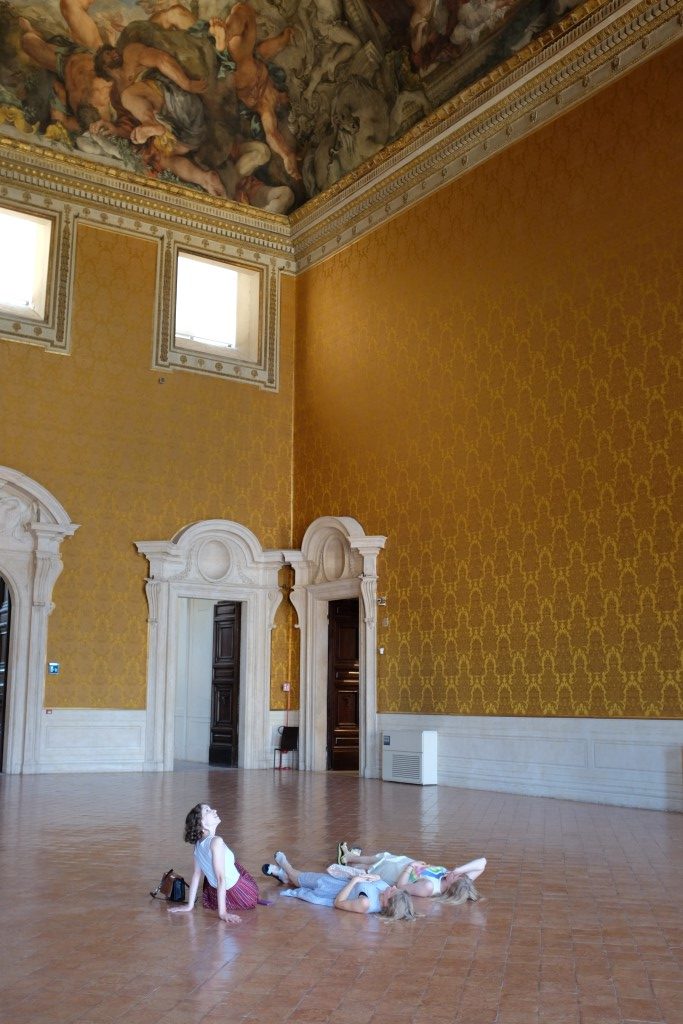
Admiring the breathtaking ceiling in the galleries. Photograph © Jo Neville. 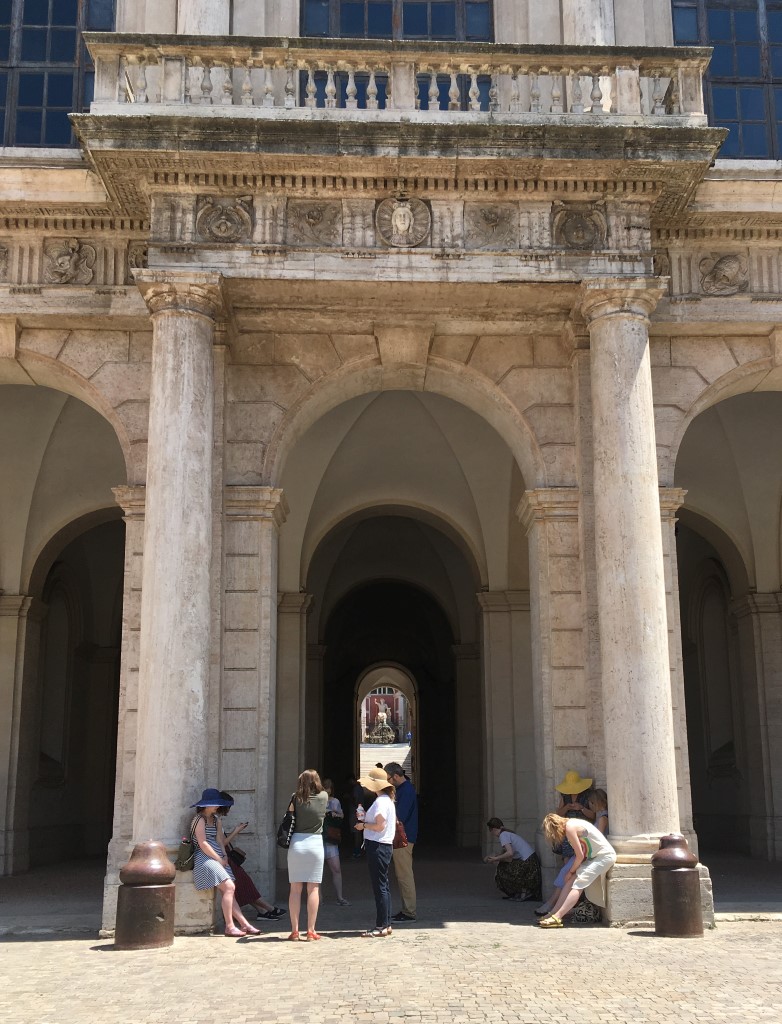
Catching a breather in the shade of the loggia at the Barberini. Photograph © Ellen Nigro.
Visit to the Istituto Centrale per il Restauro (ICR)- Maria Carolina
In the afternoon, we visited the Istituto Centrale per il Restauro (ICR), located in Trastevere in the former L’Ospizio Apostolico di San Michele. We were welcomed by the director of the degree courses, Francesca Capanna, and the head of communications and promotion, Anna Milaneschi. This institution, established in 1939 and directed initially by Cesare Brandi, is part of the Italian Ministry of Culture and Tourism and oversees the conservation, restoration, and research of works of art and cultural heritage in the country and also provides professional training in the field.
The program offered is a 5-year theoretical and practical course leading to a Laurea Magistrale in Consevazione e Restauro dei Bieni Cultural. Students attend lectures, laboratory sessions and studio work in the conservation of many types of objects: mural painting and architectural decorated surfaces, mosaic and stucco, paintings on panel, wooden sculpture, paintings on canvas, contemporary art, ceramics, glass, ivory, excavated organics, metals, leather, paper and vellum, textiles, and plaster. The teaching in conservation is given by an inter-disciplinary staff of chemists, physicists, biologists, conservation scientists, historians, art historians, architects, archaeologists, and conservators in different specialities. We were given a tour of several departments and it was incredible to learn about the conservation of so many different materials and in such depth.
The visit started in the mural painting and architectural decorated surfaces studio, where Professor Valeria Massa explained to us the students’ current projects. One of these was the stabilization and treatment of an amazing group of Roman mosaic fragments that remain from il Tempio della Gens Flavia (1st century AD,) excavated in the 1970s underneath the Palazzo del Quirinale. Following that, we visited the panel painting studio, where students were treating paintings from the Museum of Capodimonte in Naples, and they showed us their process of retouching in watercolour and Gamblin using the Italian trateggio technique.1 On a portrait that was exhibiting widespread and persistent flaking, the conservator showed us the painstaking processes by which she had addressed the flaking and was now filling the many minute losses and matching the texture to the painting’s incredibly smooth surface. In the separate studio for paintings on canvas, Professor Carla Zaccheo introduced us to the complex conservation treatment of a double-sided processional silk banner that was exhibiting multiple tears and fabric losses.
Finally, we arrived at the space reserved for treating very large paintings, an extraordinary former 17th-century jail building. Here we were shown the Fishing Pavilion Series (1918) by Humberto Coromaldi treated by the ICR. The paintings were recently the focus of a large-scale project of conservation and research, directed by art historian Laura Agostino and conservator Paola Lazurlo, during which they underwent major structural treatment including tear mending, large inserts to fill gaps in the canvas, strip-lining in polyester sailcloth, and re-stretching with a spring system to aluminium stretchers.

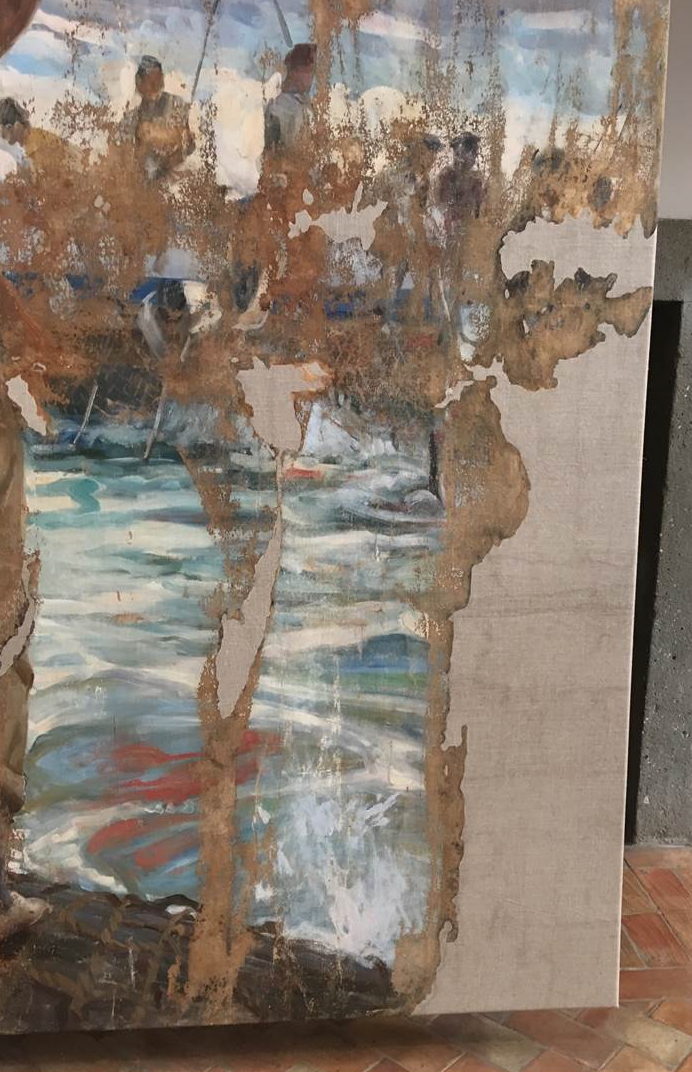
Detail of the intricate canvas infills on one of the Coromaldi paintings. Photograph © Maria Carolina Peña Mariño. 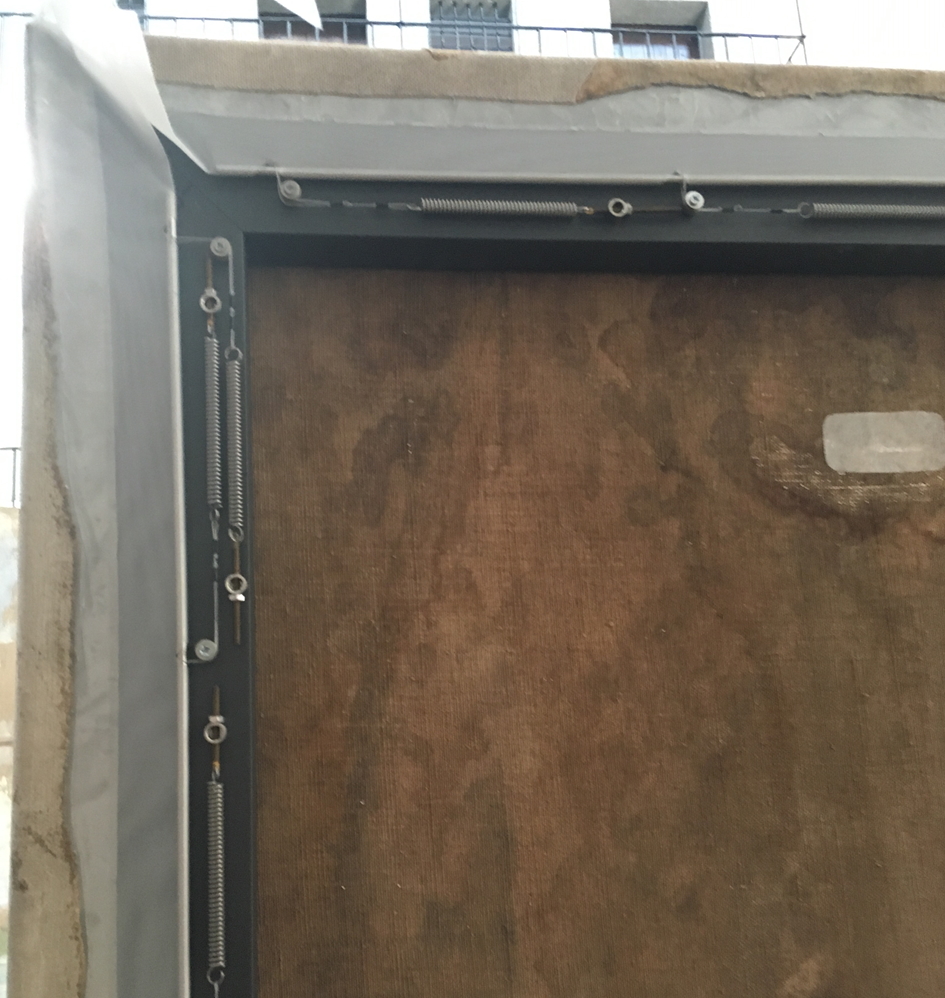
Detail of the spring-loaded stretcher of a Coromaldi painting. Photograph © Maria Carolina Peña Mariño.
Wednesday, 17th July 2019
Wednesday was reserved for travelling between Rome and Florence, so we used it as a study day and took the opportunity to explore some of the other museums and galleries in Rome. I visited the Villa Farnesina, with frescoed rooms decorated by Raphael, Sebastiano del Piombo, Baldassarre Perruzzi (who also designed the architectural layout) and other famous artists. It was particularly interesting because there were actually conservators working on some of the frescoes in the Loggia di Galatea when I visited, and as I explored, I followed a display that presented the history of conservation carried out in the villa. In recent decades, a lot of this has focused on tackling issues of vibrations caused by the relentless heavy traffic on the nearby roads, which have posed a severe threat to the frescoes.
Just around the corner was the Palazzo Corsini (the sister gallery of the Palazzo Barberini, housing artworks of the Galleria Nazionale), where I bumped into Rupert and we exchanged thoughts about some of the paintings.
Then it was time to say goodbye to Rome and head to Florence, which will be the subject of the following post. Arrivederci!
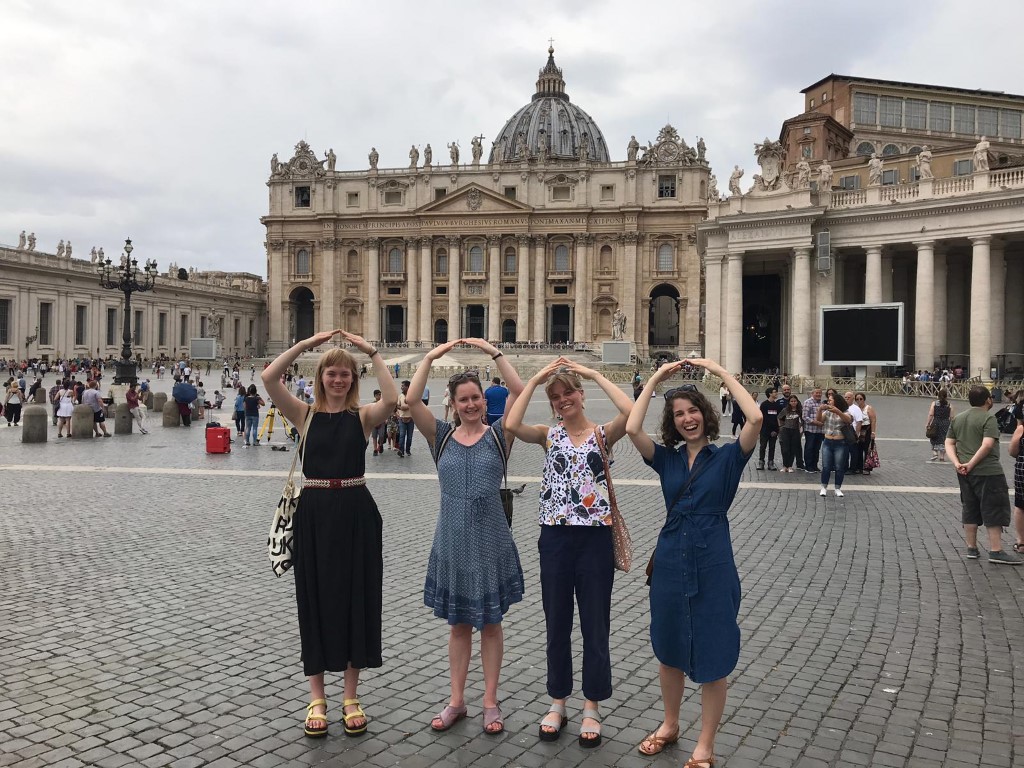
Notes
- With the trateggio retouching technique, a selection of colours are added via minute, vertically hatched strokes that are only visible when viewed close-up. The method was developed at the ICR in Rome in the mid-20th century. Trateggio is one of a number of ‘visible retouching’ techniques. This differs from ‘imitative retouching’, in which the aim is to match the appearance of the original painting as closely as possible in order to hide the losses completely. Although the latter technique is widely practised in the UK, the choice of retouching method often depends on the unique requirements of the painting in question. Muir, K., 2009. ‘Approaches to the reintegration of paint loss: theory and practice in the conservation of easel paintings’, Studies in Conservation, 54, issue sup1: Reviews in Conservation, 10: 19-28.
